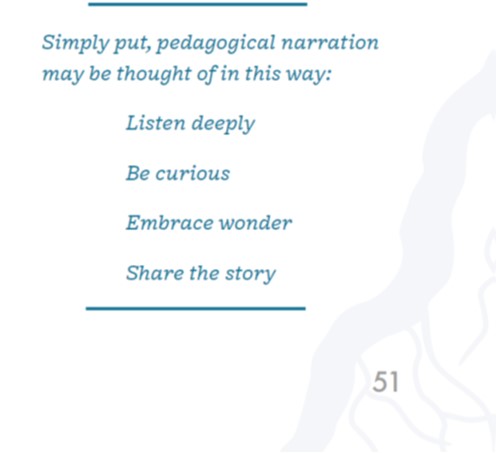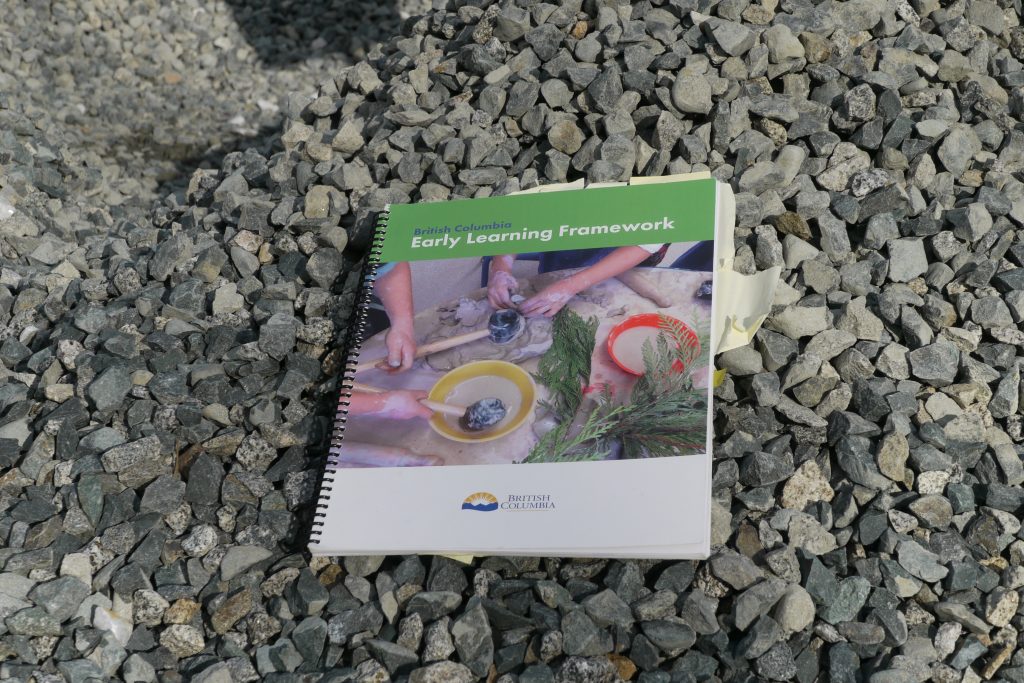By Cali Storch
Ideas Travelling and Co-Creating with Paper
By Rachel Nelson

In my class ‘Program Development for Infants and Toddlers’ we started by reading “Drawing Together” by Sylvia Kind and Gabriela Neves (2016). Together as a group, we set up the tables forming a long straight line and laying out the paper. A classmate and I went hunting and gathering materials for a provocation, while the others found a soft gentle video to play in the background. The video was of bright fall colours oranges, reds, and greens running through a river filled with rocks that had weathered many storms. We had nature items in the center of the table along with beautiful drawing materials such as charcoal and wooden pencil crayons, we started to draw what came to us from this provocation; thoughtful materials that stimulated curiosities. Our thoughts as a class were “how can we sustain this inquiry and continue art on this giant piece of paper?”
I asked to bring this to my centre and continue with the children. Giving this project new ideas and curiosities. How would the children react to a paper that had art on it already? Would they add to it? Would they want a fresh untouched piece of paper? Would they crumple the leaves? Would they be curious about why there was nature inside the class with crayons? What new ideas could the children bring with this provocation?

Over the weeks at my practicum the children experienced many provocations with this paper, we started by using it on the tables and eventually it was taped up on the wall. It became a part of our classroom. The children experienced using paint brushes with water, witnessing how paper dries and the different textures it creates, pencil crayons and markers being left out unprovoked so the children could choose if they wanted to make art during free play, painting with their hands and feet, reading by the paper, and many conversations with other educators on ideas around the paper. This paper became alive with university students’ stories and children’s stories. It was a place for free expression of art, and no expectations on how it should look or a final product.
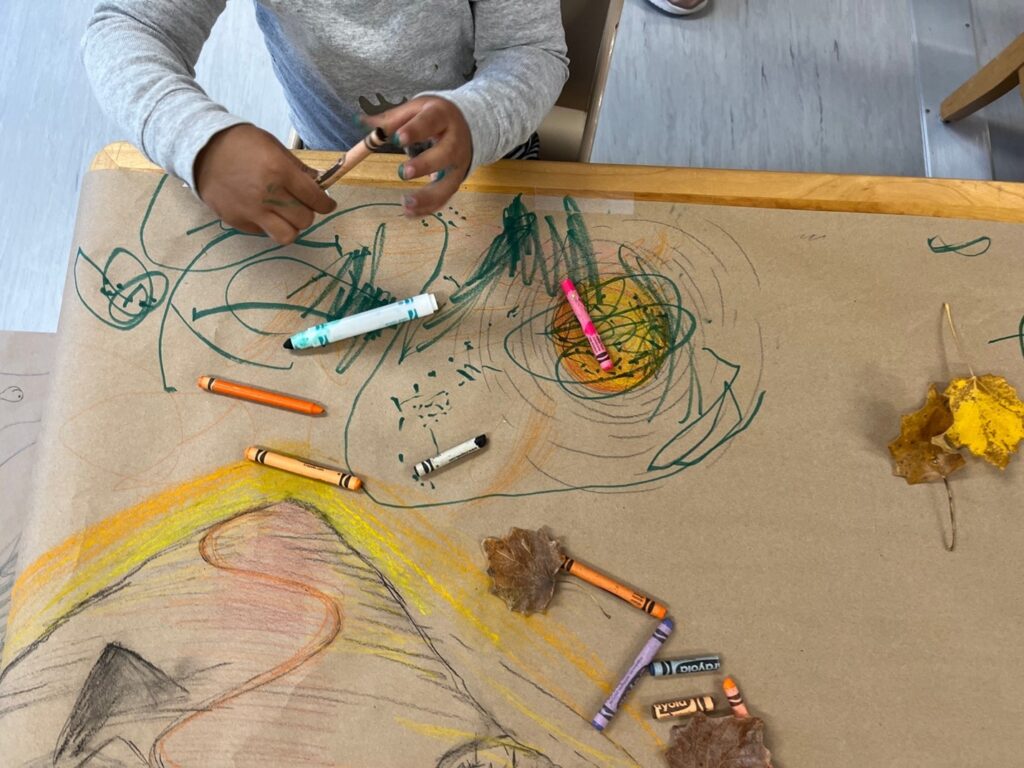
The materials were woven together between classes to sustain this inquiry, flowing to and from my centre and university, I had to let go of my expectations of what the paper should look like and release the urge to guide the children. My actions have an impact on how the children learn, and this was a big learning curve to just allow what’s happening to happen, even if the paper gets torn, messy, and stomped on. Letting go of my expectations for children’s processes, the beauty was right in front of me exploding on this piece of paper. BC ELF (Government of BC, 2019) states, “how can each child contribute their gifts in relationship with adults and other children” (p.73). Each child had a different way of connecting to the paper and with each other. We extended art over months, adding layers of curiosity and stories to the paper.
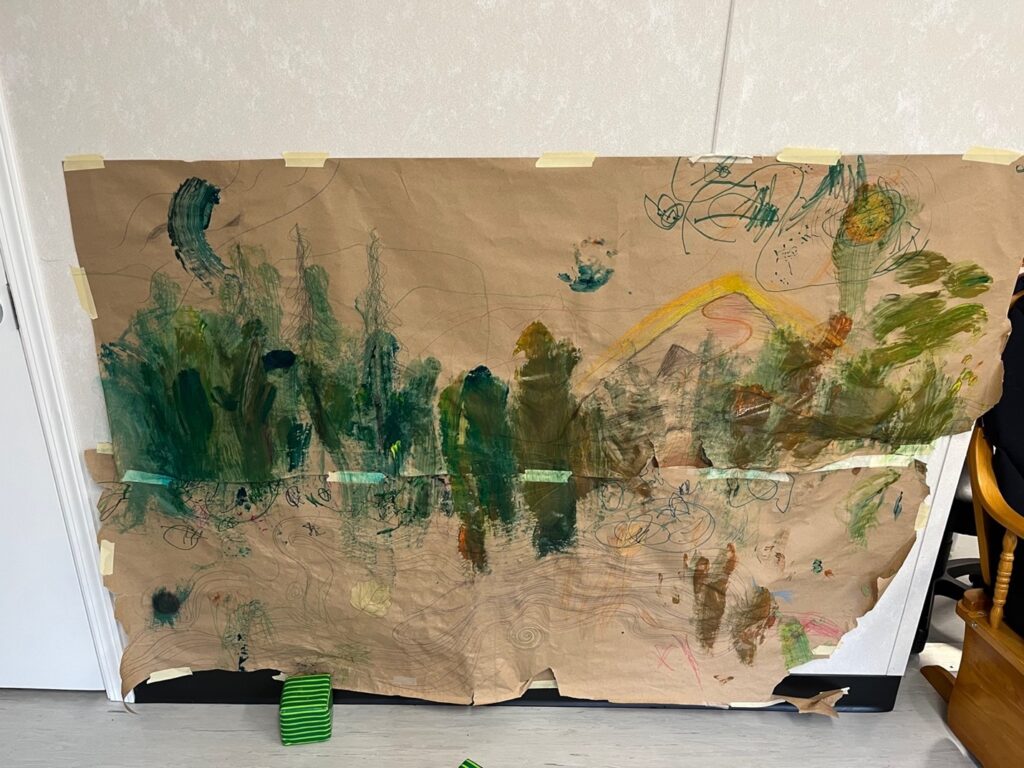
References
Government of British Columbia (2019). British Columbia Early Learning Framework. https://www2.gov.bc.ca/gov/content/education-training/early-learning/teach/early-learning-framework
Kind, S. & Neves, G. (2016). Drawing Together. The Early Childhood Educator, Winter, 27-29.
Arbutus Tree
By Clover Burgess
Arbutus Tree Ocean breeze, Qaanlhp trees High upon a rocky outcrop. Robin and wren, making friends, Eating berries red, can’t stop. Winds will blow, bark will grow, Crimson peeling bark on top. Evergreen all seasons seen, Green leathery leaves will drop. Twisted branches, long and wild, Perfect for a place to stop. Build a nest, take a rest, Baby Birds soon will hop. Ocean breeze, Arbutus tree, High upon the rocky outcrop.
With children you might add these movements:
Arbutus Tree
Ocean breeze, Qaanlhp trees (Children stand like trees balancing)
High upon a rocky outcrop.
Robin and wren, making friends, (Children pretend to be bird eating berries)
Eating berries red, can’t stop.
Winds will blow, bark will grow, (Children blow like the wind)
Crimson peeling bark on top.
Evergreen all seasons seen,
Green leathery leaves will drop. (Children fall like leaves)
Twisted branches, long and wild,
Perfect for a place to stop. (Children make branches with their arms)
Build a nest, take a rest, (Children rest on the carpet)
Baby Birds soon will hop. (Children hop like birds on a branch
Ocean breeze, Arbutus tree,
High upon the rocky outcrop. (Children are trees once more)
The Little Fawn and The Lily
Written by Cassia Broomfield
Illustrated by Maillen Garcia
It has been told that the Fawn Lily received its name because the leaves resembled those of a fawn’s ears but, nobody knows how or why the fawn lily resembles a fawn so much. That’s why I am here today. To share the legend of the little fawn and the mysterious lily.
Many centuries ago, before humans roamed the earth, there was a fawn named Artemis. She was a young doe who loved to stray from the rest of the herd and explore the new world around her. Her herd was never afraid, as they were the only animals at the time, they had so very little to worry about. The only thing that scared the herd was the mysterious lily that lived deep in the woods under a giant pine tree. Artemis did not know why they were afraid of a flower because she never listened to her elder’s warnings and cautionary tales about the lily.
One day as Artemis was exploring, she found herself in an unfamiliar place, a place that she had never been before. She looked around to see if she could find her herd, she was alone. By this time Artemis was beginning to get hungry as she had not returned to her home for dinner. She looked up at the sky, the sun had gone to bed, she was greeted by her friend the moon instead.
Artemis continued her path through the woods hoping that she would find a way back home or, at least something to eat. She crept deeper and deeper into the forest until eventually, she reached a clearing. To most, this would not seem strange, but the clearing had the sun shining through the trees; Artemis was sure that she had just seen the night sky only a few minutes ago. Her eyes scanned the mossy rocks and grass and landed upon a giant pine tree. Artemis’ stomach grumbled by just looking at the delicious pine needles. As she was just about to turn around and head home she heard a melancholic voice say “oh Artemis, are you not hungry?” the young fawn whipped her head around to try and find who was speaking to her, but all she found was a tall white lily weeping at the base of the pine. “I am hungry, lost, and very afraid” Artemis whispered back to the lily. “There is nothing to be afraid of here in the forest, come closer, I will offer some of my petals for you to ease your hunger” the lily responded in a gentle tone. Artemis fell under the spell of the lily and soon was munching happily on the now glowing white petals.
After finishing her snack, the light in the clearing turned dark and the moon was visible once again as Artemis lay on the ground and went to sleep. The lily smiled as Artemis fell into a spell-binding sleep. The moon watched helplessly as her dear friend turned into a lily very similar to the one she had eaten the petals from. The moon wept with sorrow as there was nothing she could do to help her friend. The moon’s tears reached the earth and each tear grew into the lily her friend had become. Soon the woodlands had the delicate white flowers blooming all along the forest floor. The moon did not want her friend’s life to be wasted in vain so, the moon gave the new flower the name “Fawn Lily.” Since that day the moon would continue to weep every spring and more fawn lilies would grow covering the forests with the memories of her dear friend Artemis.
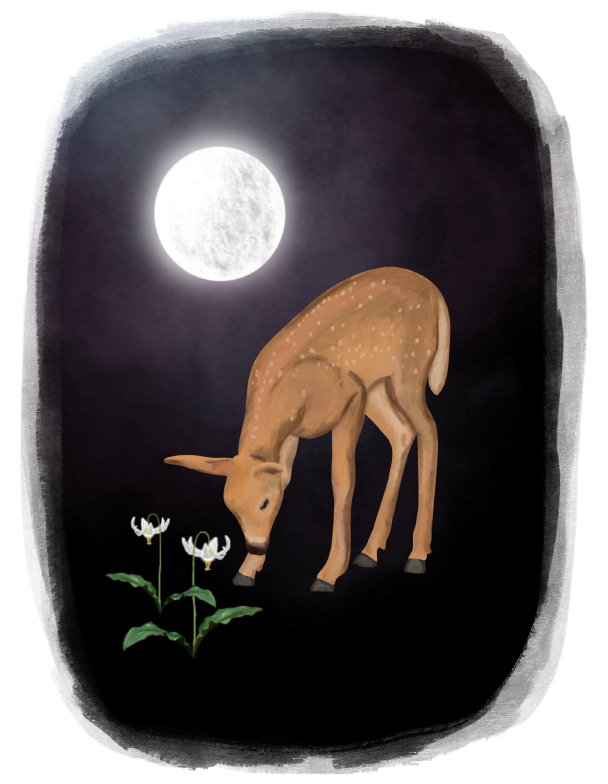
Reconnection to land and place
The Early Learning Framework (Government of BC, 2019, p.78) invites us to consider, “What does it mean to be in relationship with land? To be of a place?” Most of the time we might not think about the land so deeply because our environment and surroundings feel “natural” to us. I would like to share a story from my childhood about my relationship with nature and the land and how it affects how I feel about the land and natural space.
I was born in a quite populated city in Japan, though the city itself is small. When I was 3 years old or so my family moved to smaller town which has a lot of nature, green and ocean. I could say my hometown is countryside. My parents often took my brother and I to the park to play catch, ride a bicycle along vegetable farms, to the port to fish and the small forest to walk around and find bugs. We just loved to be outside. The land is much bigger than us and we enjoyed many possibilities to connect through these experiences we had when we were young. Even a simple thing like going to small forest to see the color of leaves in different seasons was learning and connecting with the land and nature for me.

How might we appreciate the land we are on and explore nature such as plants, trees, insects and animals? How might we notice the change of the land in seasons by colors and smells? I am reminded that “learning is embedded in memory, history, and story” (Government of BC, 2019, p. 14).
I love the smell of autumn. I remember many hikes with my grandfather in beautiful autumn mountains. I was so tired but when we got the top of the mountain and saw the color of autumn mountain, it was just stunning and I forgot about how tired I was! I will always cherish those childhood memories with my family, especially with my grandpa. He was the one taught me the fact that “being outdoor is a lot of fun” the most. My grandpa was wild enough to fight with a poisonous snake to save my brother and I, when we bumped into the snake on our big hike! I always describe him with this sentence 😊.
I love a sentence from The Service Berry by Robin Kimmerer (2020), “People come for a sense of connection to the land, a laugh with the farmer as a fellow human who cherishes the crisp fall air…”, because I can somehow feel ‘”the crisp fall air” and it made me think of the importance of cherishing the simple but warm moments with nature in our everyday life. “
References
Government of BC. (2019) British Columbia early learning framework. Victoria, BC: Queen’s Printer.
Kimmerer, R. (2020). The Service Berry. Emergence Magazine. https://emergencemagazine.org/essay/the-serviceberry/
Connect to Nature
We have known how beneficial the outdoor is for children. According to BC Early Learning Framework (2019), “Environments are integral to well-being and learning” (p 22). In addition, there are three elements that weave environments (Early Learning Framework, p. 22):
- Space and place
- Materials
- Time: rhythms and flows
The weather finally got sunny this weekend, so I’d like to show you how these three elements look like in my neighborhood, The Abyss Trail.
- Space and Place
- Materials
- Time: rhythms and flows
I was amazed by how the scenery has been changed in the fall. What I have received from nature is not just the beautiful scenery and crisp air, also the energy from the land and plants. All of those precious gifts allow me to relax, recharge, and sort my mind. As a way to engage with the world, I took some photos of art that was created by nature. The first and the second art were probably man-made. I was curious how come the moss only grew along with the pattern. The third one looked spooky, which was perfect for Halloween, I like how those fallen leaves decorated the entrance of the trail. Likewise, even just the shadow could make beautiful art as the fourth photo present. I had a lot of fun while walking the trail and appreciated the natural art, and kind of understood why Andy Goldsworthy is obsessed with it.
As a future educator, I would like to create more opportunities for children to connect to nature, allow them to choose their own natural resources, and give them time to make anything that is meaningful to them. In addition, supporting and encouraging them, or participating in their plays/ experiments if they want me to.
References
Andy Goldsworthy. (n.d.). Artnet.com. http://www.artnet.com/artists/andy-goldsworthy/
Government of British Columbia. (2019). British Columbia early learning framework. Victoria: Ministry of Education, Ministry of Health, Ministry of Children and Family Development, & British Columbia Early Learning Advisory Group.
Stones, leaves, & chalk pastels
By Rita Huang
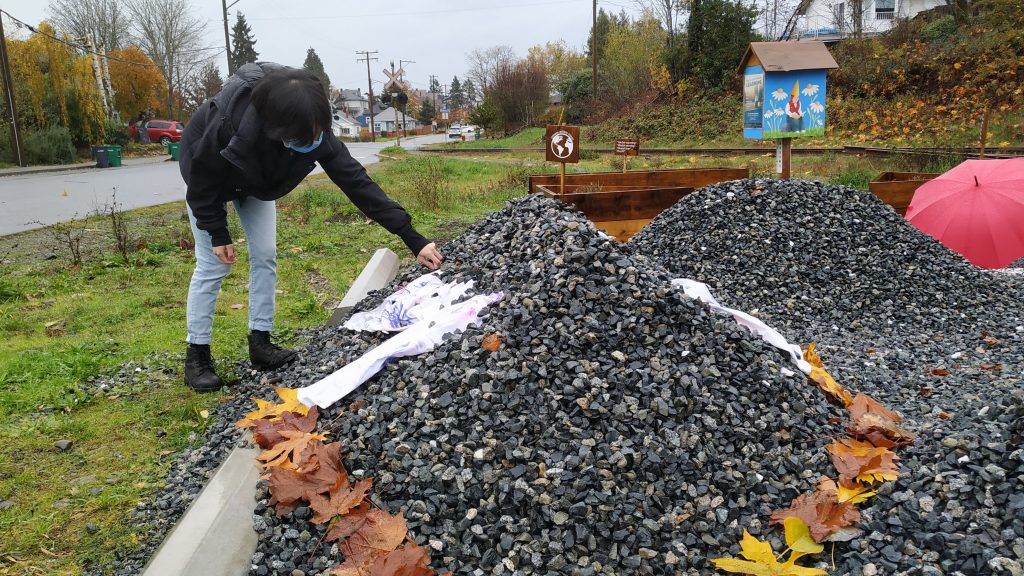
This morning, our pedagogist Antje arrived in front of our classroom to visit with us. The two of us walked down the road to a stone area, which is located at the end of a parking lot in our neighboring daycare program. The parking lot belongs to the train company and is a shared space in this community. There is a little wooden box with children’s books. Anyone is welcome to grab books from this little box and sit down on rocks or benches.
We spent time in this rock area
To see what we could do or create
We took a few minutes to stand under the rain
It brought energy and calmed us down
Time passed fast, leaves fell down from trees
We are almost at the end of the fall
I said, “ If we are only looking at the rocks, we won’t feel time changing, even thousands and thousands of years. However, when we see leaves as they lay down on the rocks, we know time is changing.” We illustrated this idea in this way with the stones and leaves:

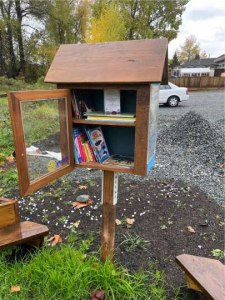
This library area is open to their neighbourhood. Antje shared an idea from one of my classmates: “I wonder what would happen if we put the BC Early Learning Framework here?” I was inspired by this idea. Perhaps we could offer a blog or a memory notebook beside the library, and share one of the Principles from Early Learning Framework, which uses the environment as the third teacher. People from this community and neighbourhood are welcome to sit down and spend time to share their thoughts on the blog or note book.
We decided to bring rocks from the stone pile to the centre, along with fallen leaves that we found on our way back. We moved the stones and leaves to the centre’s backyard. Children dressed for the rain and came with muddy bodies. We invited the children to sit around a table and told stories about this project to the children. We were going to play with chalk pastels, rocks, and leaves on a large sheet of paper. I was curious, ‘ What might the children create and how might they build a relationship with those fresh materials?’ We wouldn’t know at the beginning. I noticed some children saw the chalk pastels as a gift and chose their favourite colours and had fun on paper.

Thanks for reading!
References:
Government of BC. (2019) British Columbia early learning framework. Victoria, BC: Queen’s Printer.
Hand-gripped Materials
Posted on 2021-12-02 by michael3
I’m reflecting on the experience last night at the Collaborative Dialogue Event (ECPN’s put on). The story of Kozue especially on the little children’s grip of ‘things’ they bring to the day care in her experience. She lists several things they bring, and small stones is one of them. Tonight, I’m thinking, that if I was a child again, and had the choice, I would have brought a small pencil (or like stylo-instrument, be it a crayon, pastel, pen). I have had a fettish for these objects since I can remember, and it is not surprising my desk and art studio are cluttered with these materials (evocative objects–so I decided to scan my gripping the pencil as if that is my child’s hand at a toddler age)- I think of adults or older peers prying against the will of the child in many instances, even my own, where something inside one’s hand is forcibly removed because the child doesn’t want to give it up. That was part of Kozue’s realization of having a “relationship with the stone” which she has shared on a prior blog post here and she shared her written story at the Event last night online.
Now, what takes this all further in my query, is not that I am a ‘collector’ of such stylo-like things and love what they can do in terms of their marking the world, the sidewalk, the blackboard, the whiteboard, the paper, etc. but I have on several occasions made paintings in experimental series where I draw, color, and paint realistically a stylo object, a pencil crayon, a pastel, a felt-tipped child’s marker. In fact in the current show at NIA starting this Sat.-Sun. (for the Nanaimo Artwalk) you’ll see at least two of my paintings where I included such an object. Okay, that’s interesting enough. But what really came out tonight, from the unconscious to conscious, was that “I am a pencil crayon.” Yeah, all those objects truly are “me” and they are what and how I want to be handled in the world–artistically, as I and many of us would handle a pencil crayon (or any stylo objective I’ve mentioned above). Wow! There’s a lot there to mine. But, let’s also not forget the stones, as a theme for this artist residency and Kozue’s story, in hand–and, now in her son’s hand. As she told us last night that her son “took the stone” –her stone. What part of her did he take, and apparently has still hidden, even from his mom?
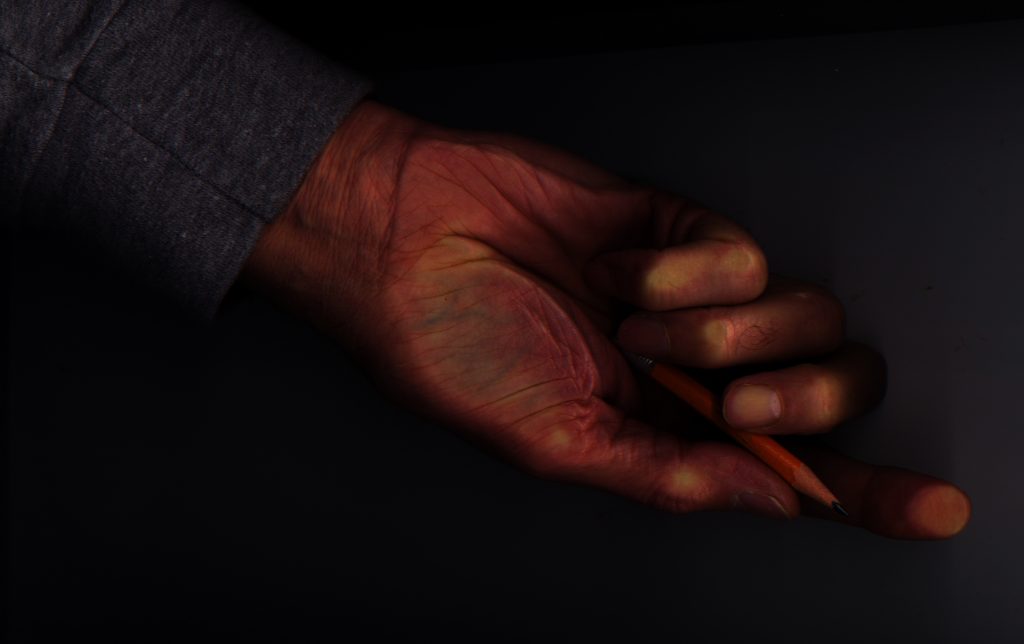
Imaginary tour with my stone
By Kozue Rathe
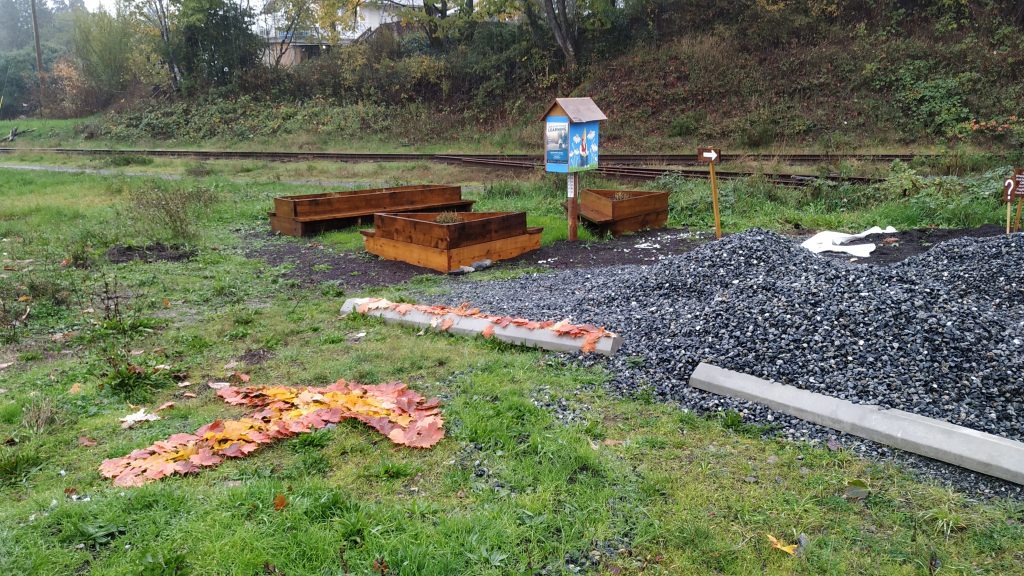
On a rainy Saturday morning my colleagues and I gathered at our children’s centre for an event called “strengthening our learning community through art as inquiry”. We started the day with the visit to the rock art exhibition in the neighboring parking lot. Our artist in residence, Michael, invited us to pick a stone to bring back as we were going back inside. I picked a small white stone with many black dots on it. I chose it for its small size and for the one shiny black spot that I noticed after I picked it up. As we got inside, I kept an eye on the stone while I tried to find a comfortable seating position. Michael who was leading the experience told us to lay down or get comfortable, then close our eyes in preparation for our imaginary tour around our neighborhood.
I sat with my eyes closed listening to the voice of Michael. The little stone was in my hands. The imaginary walk started at our children’s centre and took us in three directions: to a cliff, a nearby park, and a large rock. We were encouraged to feel the stone and talk to it at times. Whenever we paused for a moment, I asked the stone if it wanted to keep going. The answer was always “Yes” as it was a young stone with many pointy edges. I, on the other hand, am old (not that old) and smooth from going over the bumps of life. Throughout this imaginary tour, the rock stayed in my hand. I sometimes moved it around in my hands feeling the bumpy surface of it, or sometimes it just rested on my hand. By the time I opened my eyes as the imaginary tour came to an end, I had formed a relationship with the stone. It even looked like it had two dotted eyes and a small pointy nose.
While I was going through the tour, I thought of the children who were in my infant and toddler class. They come through the gate to our yard with one or more stones in their small hands tightly gripped almost every morning. There is also a child who comes with a piece of gummy which he never eats. While infants and toddlers often like to have things such as stones, toys, nuts, bugs, flowers, and food in their hands, they do not like to let them go. Although a piece of gummy from the breakfast could be too dirty to be eaten after one hour of outside play, it is still difficult for the child to let it go. I never thought of the fact the tight grip on a cereal, gummy or a rock was a sign of the relationship. The child has formed a relationship with the object in its hand and it makes it hard to open the hand to part with it. It could be because the cereal came from home where the child longs to go back, or the child feels the connection with his family or parents who he loves. A stone at the parking lot might have caught the child’s eye with a noticeable shine. Also, the roughness of the stone may give just the right amount of sensory stimulation on the soft palm.
In any case, any object can form a relationship with a child if a grownup who has not visited any imaginary world for a long time can have a relationship with a stone.
The experience with the stone gave me the opportunity to vision the world of imaginary play of children as well as the relationship between objects and children.
As I wrote this, my 6-year-old son wanted me to read the story I was working on. I read him the first two paragraphs, and he asked me if it was a true story. I said,” yes.” Then he wanted to see the stone I was writing about, because he wanted to see the spots that was shiny. He did not question about the fact that I was talking to the stone or the relationship between the stone and I. I felt as though I was allowed in a special place where it was filled with children and only chosen adults.
Collaborative Dialogue: Of Stones and Community-in-the-Making
Dear all,
With much delight we are sharing some traces from our Collaborative Dialogue event from December 1st, 2021. We look forward to continuing this series in the New Year and welcome your ideas for future events. In the meantime, to continue thinking with each other, we invite you to share your reflections as a response to this post.
Thank you for attending the Collaborative Dialogue #3- Thinking Education through Art(s). Using the music of the stones and the symbols of candles, an environment was created in which we, as educators could reflect, investigate and be provoked to deepen our understandings of others, of materials and of our world. We are grateful for the opportunity of having artist R. Michael Fisher join us last night and to open the conversation on how we can be curious to think with, question with and trust with, the arts / artists / pedagogists / children / educators / mentors / the non – human world and materials. You can view Michael’s online exhibition here: https://galleries.lakeheadu.ca/r-michael-fisher.html
Kozue shared of her relationship with the stone she picked and wondered about when the children come to us, holding a stone, a gummie candy, a toy, and their genuine relationship to this object. She reminded us to take notice of how a stone feels in hands, what it looks like, to think of our connection to the stone.
Rita shared her observations of what can happen when we ask the question of “what relationship will the children build, what will they create, when they can investigate and experiment with materials in a way that are meaningful the them?” She reminded us to consider how materials are presented. How do this invite experimentation and curiosity? To notice the contrast of colour between stones and leaves, the contrast of time.

Jennifer shared stories of neighborhood walks that take the children past the stone pile in their community. She brought in the voice of a child who excitedly shares on these walks: “That’s my neighborhood!”
In one break out room the discussion was on the inter-relationship of humans and natural environments. How can I encourage children to recognize that humans and the natural world are connected and mutually dependent on one another? (to read further questions, see page 90 of ELF). Only through ongoing inquiry of our connections to nature, to objects, can we engage with the children in their journey of “recognizing that humans and the natural world are connected and mutually dependent on each other”. (ELF pg.84)
Best and thanks to you all,
Cheryl & Antje & Juliet
Consider this inquiry into the stones. How did the protagonists engage in the process of pedagogical narration?
